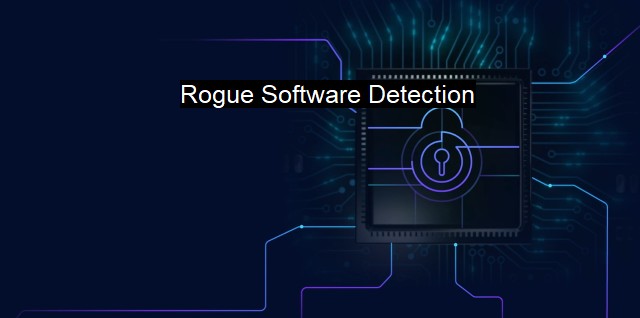What is Rogue Software Detection?
Rogue Software Detection and Antivirus Solutions: Safeguarding Computer Systems and Networks from Malware Threats
Rogue software detection is a crucial aspect specifically in antivirus applications and programs. To understand what it is, it is essential first to understand what rogue software is. Rogue software, also known as rogueware, scareware, or fraudware, refers to a kind of malicious software designed to deceive or mislead users. These software lead users to believe that their system is at risk and requires immediate action, typically prompting them to download and install unnecessary software, often for a fee. Rogue software detection, therefore, refers to the process of identifying such deceptive programs.Rogue software attempts to present itself as legitimate security software, often disguised as antivirus or antispyware applications. Once installed on a device, the rogue program creates alarming security alerts or exaggerated threat reports to create an illusion of an infected system. The objective is to deceive users into believing that the falsely reported issues will be fixed if they upgrade or purchase a full version of the software, which would allegedly remove the non-existent threats. In extreme cases, this type of malicious software may also redirect web browsers to malicious websites, slow down systems, or disable legitimate software.
Rogue software detection assumes significant importance in this context. Detecting and combating this software is important because, apart from its immediate damaging effects, the rogue software can lower defenses against other forms of malware or even serve as a gateway for them, escalating the harm to the system. Notably, rogue software is often used as a delivery vehicle for more sinister threats like Trojans, worms, ransomware, or keyloggers. it can lead to the unauthorized collection and transfer of personal and financial data, leading to severe privacy and financial implications.
There are several tools and techniques used in rogue software detection. Signature-based detection is one of the most common, in which known rogue software samples are compared with incoming coded files, looking for a match. Another technique often utilized is heuristic-based or behavior-based detection, enabling identification of previously unknown threats by observing behavior patterns and comparing them to known rogue software behavior.
To enhance rogue software detection, various approaches are combined to increase the efficiency of the process. machine learning and artificial intelligence have begun contributing to these efforts. Machine learning algorithms can learn from historical data to identify patterns in rogue software and allows predicting new or evolving rogue software threats, providing a completely new way of detecting and combating such physically devastating threats. Apart from this, constant updates to antivirus software's threat databases, known as threat intelligence, are also critical in enhancing rogue software detection.
On the user side, the best protection from rogue software starts with awareness and a healthy level of skepticism. Rogue software tends to exploit the fear that customers have regarding computer security. Users should only rely on trusted sources for their security software, avoiding obscure websites and software that heavily monetizes their promotion. Regular backups also ensure that data can be recovered if a rogue software attack does occur, while keeping system, application, and security program updates current boosts defenses against this digital deception.
Rogue software detection is an eminent part of the cybersecurity and antivirus world. It aims at identifying and limiting the reach of rogue software that deceives users and tricks them into exacerbating their system's vulnerabilities. Software engineering tools and techniques, coupled with user awareness and vigilance, contribute to achieving this objective. As rogue software continues to evolve and pose a significant threat to digital security, this field will undoubtedly continue to establish itself as a key defensive tool.

Rogue Software Detection FAQs
What is rogue software detection?
Rogue software detection refers to the process of identifying and removing malicious software (also known as rogueware) from a computer or network system. It involves using various cybersecurity tools and techniques to detect and remove any unauthorized software that may be running on the system.Why is rogue software detection important?
Rogue software can cause serious damage to a computer or network system. It may steal sensitive data, compromise security, slow down the system, or even crash it. Rogue software detection is important because it helps prevent these types of attacks and ensures that the system is running efficiently and securely.What are some common tools used for rogue software detection?
Some common tools used for rogue software detection include antivirus software, intrusion detection systems, network scanners, and malware analysis tools. These tools help detect and remove malicious software, monitor system activity for suspicious behavior, and identify potential vulnerabilities.How can I ensure that my system is protected against rogue software attacks?
To ensure that your system is protected against rogue software attacks, it is important to regularly update your antivirus software, scan your system for vulnerabilities, and avoid downloading software from untrusted sources. You should also keep your operating system and other software up-to-date with the latest security patches and updates. Finally, it is important to educate yourself on the latest cybersecurity threats and best practices to stay informed and aware of potential risks.| | A | | | B | | | C | | | D | | | E | | | F | | | G | | | H | | | I | | | J | | | K | | | L | | | M | |
| | N | | | O | | | P | | | Q | | | R | | | S | | | T | | | U | | | V | | | W | | | X | | | Y | | | Z | |
| | 1 | | | 2 | | | 3 | | | 4 | | | 7 | | | 8 | | |||||||